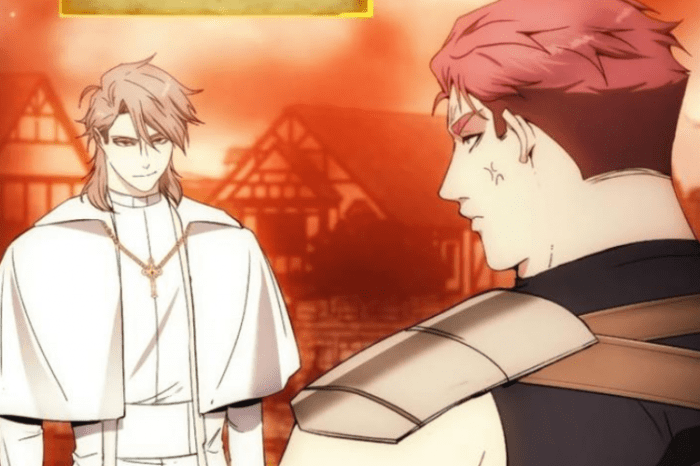
How to live as a villain ch 94 – Prepare to delve into the dark depths of villainy with “How to Live as a Villain Chapter 94.” This chapter delves into the strategies, motivations, and powers that fuel the most notorious villains. From the cunning machinations of masterminds to the chaotic rampages of power-hungry tyrants, this guide unveils the secrets of the villainous underworld.
In this chapter, you’ll discover the art of manipulating others, the psychology behind evil, and the sources of power that villains wield. Join us as we explore the complex relationships between villains and their allies, enemies, and victims. Together, we’ll unravel the impact of villainy on society and its potential to inspire change or challenge societal norms.
Villainous Strategies

In the annals of villainy, certain strategies have proven time and again to be the most effective in achieving nefarious goals. These strategies, employed by the most successful villains throughout history, offer a roadmap for those who seek to embrace the dark side.
The first and foremost strategy is the art of deception. By creating a facade of trustworthiness and manipulating others, villains can gain access to sensitive information, resources, and opportunities that would otherwise be unavailable to them. The Joker, with his chaotic and unpredictable nature, exemplifies the power of deception, using it to sow chaos and terror among his enemies.
Divide and Conquer, How to live as a villain ch 94
Another effective strategy is to divide and conquer. By exploiting existing divisions or creating new ones, villains can weaken their opponents and make them more susceptible to manipulation. Darth Vader’s infamous “Rule of Two,” which limited the number of Sith Lords to only two at a time, ensured that his power would not be challenged from within.
Intimidation and Fear
Intimidation and fear can also be powerful tools for villains. By projecting an aura of menace and ruthlessness, they can deter opposition and create an atmosphere of terror that paralyzes their enemies. The Dark Lord Sauron, with his vast armies and overwhelming power, instilled such fear in the hearts of Middle-earth that even the bravest warriors trembled at his name.
Psychological Manipulation
Psychological manipulation is a subtle but deadly strategy employed by many villains. By understanding the weaknesses and fears of their opponents, they can exploit them to gain control and bend them to their will. Hannibal Lecter, the brilliant and cannibalistic psychiatrist, used his psychological insights to manipulate and torment his victims, leaving them broken and terrified.
If you are wondering how to live as a villain, then check out how to live as a villain ch 94 and see how things get real. You will see a world of darkness and despair that will make you question your own morality.
But in the end, you will come to understand that there is more to life than just being good.
Exploiting Chaos
Chaos can be a valuable ally for villains. By creating or exploiting existing chaos, they can disrupt their opponents’ plans, create opportunities for themselves, and sow confusion among the ranks of their enemies. The Joker’s reign of terror in Gotham City is a testament to the power of chaos, as he uses his anarchic tendencies to bring the city to its knees.
It’s important to note that each strategy carries its own risks and rewards. Deception can backfire if the villain’s true nature is discovered, while intimidation can provoke retaliation from those who are not easily intimidated. Psychological manipulation requires a deep understanding of human nature, and exploiting chaos can be a double-edged sword that can also harm the villain if they lose control.
Villainous Motivations

Villains are often driven by a complex mix of motivations. Some of the most common include:
- Revenge:A desire to avenge a perceived wrong or injustice.
- Power:A desire to control others or achieve a position of dominance.
- Wealth:A desire to acquire material possessions or financial gain.
- Chaos:A desire to create disorder and destruction.
- Idealism:A belief that their actions are justified in the pursuit of a greater good.
These motivations can be influenced by a variety of psychological and emotional factors, such as:
- Trauma:A traumatic event can lead to feelings of anger, resentment, and a desire for revenge.
- Narcissism:A grandiose sense of self-importance and a need for admiration can lead to a desire for power and control.
- Psychopathy:A lack of empathy and remorse can lead to a willingness to harm others.
- Sadism:A desire to inflict pain and suffering on others.
- Antisocial personality disorder:A disregard for the rights of others and a lack of remorse for harmful behavior.
Society and environment can also play a role in shaping villainous motivations. For example, poverty, inequality, and discrimination can create conditions that lead to feelings of anger and resentment, which can in turn motivate individuals to engage in criminal or violent behavior.
If you’re looking for a villainous adventure, check out how to live as a villain ch 94 . It’s got all the action and intrigue you could want in a villainous tale. And if you’re looking for more villainous content, be sure to check out the rest of the how to live as a villain series.
Impact of Society and Environment
The impact of society and environment on villainous motivations is complex and multifaceted. Some of the key factors that can contribute to villainous behavior include:
- Poverty and inequality:Poverty and inequality can create conditions that lead to feelings of anger and resentment, which can in turn motivate individuals to engage in criminal or violent behavior.
- Discrimination:Discrimination can lead to feelings of isolation and alienation, which can in turn make individuals more susceptible to recruitment by extremist groups.
- Lack of opportunity:A lack of opportunity can lead to feelings of frustration and hopelessness, which can in turn motivate individuals to engage in criminal or violent behavior.
- Exposure to violence:Exposure to violence can desensitize individuals to violence and make them more likely to engage in violent behavior themselves.
It is important to note that not all individuals who experience these conditions will become villains. However, these factors can increase the risk of villainous behavior.
Villainous Powers and Abilities

Villains possess an array of unique powers and abilities that set them apart from ordinary individuals. These powers can range from superhuman strength and agility to the ability to manipulate the elements or control minds.
The sources of these powers vary widely. Some villains are born with their abilities, while others acquire them through scientific experiments, magical rituals, or supernatural encounters. The limitations of these powers also vary, with some being permanent and others having specific triggers or conditions.
How Villains Utilize Their Powers
Villains utilize their powers to achieve their goals, which can range from personal gain to world domination. Some villains use their powers to commit crimes, while others use them to further their political or ideological agendas. The specific ways in which villains use their powers depend on their individual motivations and abilities.
Villainous Relationships

Villains rarely operate in isolation. They form complex relationships with allies, enemies, and victims, each of which shapes their journey and goals. These relationships are often driven by a combination of power dynamics, shared interests, and personal motivations.
Allies can provide villains with support, resources, and a sense of belonging. They may share the villain’s goals or simply be drawn to their charisma or power. However, alliances can also be fragile, as allies may betray each other for their own gain.
Enemies
Enemies pose a constant threat to villains. They may seek revenge for past wrongs, oppose the villain’s goals, or simply be driven by a desire to destroy them. Villains must constantly be on guard against their enemies, as even the smallest mistake can lead to their downfall.
Victims
Victims are those who have been harmed by the villain’s actions. They may be innocent bystanders, rivals, or even the villain’s own loved ones. The villain’s relationship with their victims can be complex, as they may feel guilt, remorse, or even a twisted sense of satisfaction.
Villainous Impact on Society: How To Live As A Villain Ch 94
Villains are not merely individuals who commit crimes or acts of evil; they can also have a profound impact on society as a whole. Their actions can sow fear, chaos, and destruction, leaving lasting scars on the communities they target.
However, villains can also be catalysts for change, challenging societal norms and inspiring individuals to fight for justice.
Consequences of Villainous Actions
The consequences of villainous actions on society can be devastating. Villains can cause widespread fear and panic, disrupting daily life and creating a sense of unease among the population. Their actions can also lead to physical and psychological harm, including loss of life, property damage, and emotional trauma.
In extreme cases, villains can even destabilize entire nations or regions, leading to war, famine, or other humanitarian crises.
Villains as Catalysts for Change
Despite their destructive potential, villains can also be agents of change. By challenging societal norms and exposing the flaws in the system, they can inspire individuals to question the status quo and fight for a more just and equitable world.
The latest chapter of the web novel “How to Live as a Villain” is out, and it’s a doozy! The story follows the adventures of a young man who is reincarnated into the world of a video game as the main antagonist.
In this chapter, our hero must face off against a powerful new enemy. Will he be able to overcome the odds and continue his quest for revenge? Find out in how to live as a villain ch 94 !
Some villains may even have noble intentions, seeking to create a better society according to their own twisted vision. While their methods may be questionable, their actions can nonetheless spark important conversations about social issues and inspire people to take action.
Conclusion
The impact of villains on society is complex and multifaceted. While their actions can cause fear, chaos, and destruction, they can also inspire change and challenge societal norms. Ultimately, the legacy of a villain depends on the nature of their actions and the response of the society they target.
Closing Notes
As you navigate the treacherous path of villainy, remember that power comes with great responsibility. Whether you seek to conquer kingdoms, manipulate minds, or unleash chaos upon the world, the choices you make will shape your destiny. Embrace the darkness within, but never forget the consequences of your actions.
The world awaits your villainous rise, but it is up to you to determine the legacy you leave behind.
FAQ Compilation
What is the ultimate goal of a villain?
The ultimate goal of a villain varies depending on their motivations. Some seek power, while others crave chaos or revenge. The villain’s goals shape their strategies and actions.
What are the common motivations for villainy?
Villains are driven by a wide range of motivations, including greed, power hunger, revenge, and a desire to challenge societal norms. These motivations fuel their actions and shape their personalities.
How do villains obtain their powers?
Villains can acquire their powers through various means, such as supernatural gifts, scientific experiments, or ancient artifacts. The source of their powers often influences their abilities and limitations.





